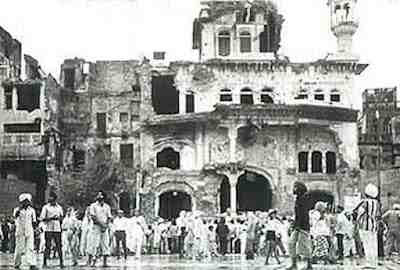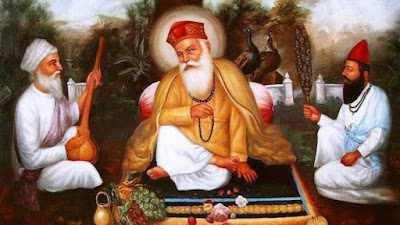Sikh Movement
The Sikh Movement had origins in the medieval period when saint-preacher Guru Nanak, founded the Sikh religion, which started as a minor religion,
but developed into a prominent religion over the centuries. There were ten recognized living Gurus in the Nanak line:
Ten Sikh Gurus and Their Teachings
1. Guru Nanak (c.1469 - 1539 CE)
• Founder of Sikhism, who was born in Talwandi near Lahore in a respectable family of accountants.
• Rejected the authority of the Vedas and preached the new idea of God as the supreme, universal, all-powerful, truthful, formless, fearless, without hate, self-existent, ever-lasting creator of all things,
the eternal and absolute truth.
• He denounced caste distinctions and rituals like bathing in holy rivers, and promoted equality of all human beings, including women. He argued that the caste and honour should be judged by the acts or the deeds of individuals. He lay emphasis on concepts of justice, righteousness and liberty.
• His conception of religion was very practical and sternly ethical. He encouraged people to give up selfishness, falsehood and hypocrisy and advised them to lead a life of truth, honesty and kindness. He guided people to follow the principles of conduct and worship: sach (truth), halal (lawful earning), khair (wishing well of others), niyat (right intention) and service to the lord 'Abide pure amidst the impurities of the world' was one of his famous sayings.
• His philosophy consists of three basic elements: a leading charismatic personality (the Guru), ideology (Shabad) and organization (Sangat).
• He repudiated idol worship and did not favour pilgrimage, nor did he accept the theory of incarnation. He condemned formalism and ritualism.
• He introduced the concept of Langar (a community kitchen).
• His main teachings can be summarized as:
1. Faith in one true lord
2. Worship of the name
3. Necessity of the guru in worship of the name
• God conceptualized as Nirguna (attribute less) and Nirankar (formless).
2. Guru Angad (c. 1539 - 1552 CE)
• His real name was Bhai Lehna.
• He standardized and popularized the Gurumukhi script of the Punjabi language.
• He established new religious institutions to strengthen the base of Sikhism and opened many new schools.
• He popularized and expanded the institution of Guru ka Langar.
• He started the tradition of Mall Akhara for physical as well as spiritual development.
3. Guru Amardas (c. 1552 - 1574 CE)
• He reformed the Langar and gave more importance to it.
• Divided his spiritual empire into 22 parts called Manjis, each under a Sikh and also Piri system.
• Strengthened the Langar community kitchen system.
• Preached against the Hindu society's sati system(the act of burning alive of a wife at the pyre of her deceased husband), advocated widow-remarriage and asked the women to discard the Purdah (veil worm by women).
• Asked Akbar to remove the toll-tax (pilgrim's tax)
for non-Muslims while crossing Yammuna and Ganges rivers.
4. Guru Ramdas (c. 1574 - 1581 CE)
• Composed the four Lawans (stanzas) of the Anand Karaj, a distinct marriage code for Sikhs separate from the orthodox and traditional Hindu Vedic system.
• Had very cordial relations with Akbar. Akbar granted him a plot of land where the Harmandir Sahib was later constructed. Interestingly, the first brick of Harmandir Sahib was laid down by Hazi Mian Mir (a Muslim).
• Guru Ramdas also laid the foundation stone of Chak Ramdas or Ramdas Pur, now called Amritsar.
• Strongly decried superstitions, caste system and pilgrimages.
5. Guru Arjun Dev (c. 1581 - 1606 CE)
• Compiled the Adi Granth i.e. Guru Granth Sahib, and installed it at Sri Harmandir Sahib.
• Completed construction of Amritsar, Taran and Kartarpur.
• Executed by Jahangir for helping his rebellious son Khusrau, and was thus hailed as the first martyr of the Sikh religion, and as Shaheedan-de-Sartaj (The crown of martyrs).
6. Guru Har Govind (c. 1606 - 1644 CE)
• Longest tenure as Guru. He transformed Sikhs into a militant community, established the Akal Takht, and fortified Amritsar.
• Waged wars against rulers Jahangir and Shah Jahan, and defeated a Mughal army at Sangrama.
• He took the title of Sachcha Padshah.
• Shifted his headquarters to Kartarpur.
• Was the proprietor of the concept of miri and piri (keeping two knives).
7. Guru Had Rai (c. 1644 - 1661 CE)
• Gave shelter to Dara Shikoh (brother of Aurangzeb, and his rival to the Throne), and thus was persecuted by Aurangzeb, who framed charges of anti-Islamic blasphemy against the Guru and the Guru Granth Sahib.
8. Guru Har Kishna (c. 1661 - 1664 CE)
• Was forcibly summoned to Delhi, the imperial capital of Aurangzeb, under framed charges.
• According to tradition, he died at a young age of 8 years due to smallpox, which he contracted while healing the sick people during an epidemic.
9. Guru Tegh Bahadur (c. 1665 - 1675 CE)
• Revolted against Aurangzeb, but was executed by him and was beheaded before the public in Delhi's Chandni Chowk in 1675 CE. The Sis Ganj Sahib Gurudwara stands at the site of his martyrdom today.
• He appointed Banda Bahadur as the military leader of the Sikhs.
• Credited with spread Sikhism to Bihar and Assam.
10. Guru Gobind Singh (c. 1675 - 1708 CE)
• Last Sikh Guru in human form, who passed the Guruship of the Sikhs to the Guru Granth Sahib. He died of complications from stab wounds inflicted by an Afghan, believed to have been sent by the Mughal governor, Wazir Khan.
• He was born in Patna and organized the Sikhs as community at warriors and called them Khalsa in 1699 CE.
• To create a sense of unity among the Sikhs, the Guru started some practices which were to be followed by, Sikhs. These were: initiation through baptism by the double-edged sword, wearing uncut hair, carrying arms and adopting the epithet Singh as part of the name.
• He selected five persons known as the Panj piyare (the five beloved), and requested them to administer the Pahul (amrit chakhha) to him.
• Compiled the supplementary granth of Deswan Padshan Ka Granth.




























0 Comments
If you have any doubt please let me know